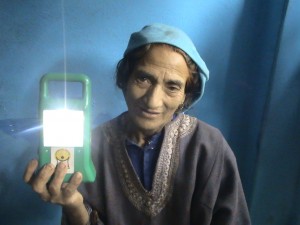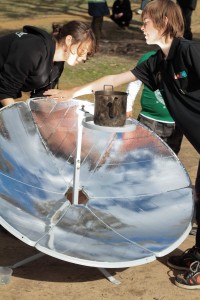We will publish at the website the results for the top three people’s-choice photos in October, before the Conference.
Please vote for your favorite photo:
 Jacek Cislo (Poland)
Jacek Cislo (Poland)
Caption: Biofuels
Description: Biofuels way to reduce unemployment in rural areas – the demand for rape (biomass). Modern car engines are suitable for biofuel.
This is a chance to the clean environment and reduce greenhouse gas emissions into the atmosphere.
The picture was taken in Europe in Poland (Silesian Region). Car in the picture has a motor adapted to biofuels from rape. Thanks to the development of biofuel production decreased unemployment in rural areas.
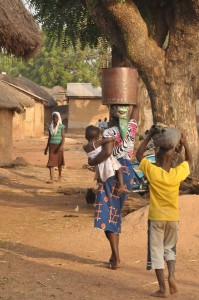 Sathyan Velumani 3 (India)
Sathyan Velumani 3 (India)
Caption: Double Load
Description: In Dec 2011, I had the opportunity to conduct field research near Savelugu Village, Northern Region, Ghana. In this dry and dusty place everyday life isn’t easy. With their struggle to get the most basic need of life, water, everything else becomes secondary. The size and shape of water containers are so many and so is the size of the people who carry them. Daily life didn’t stop because of this, they pray 5 times a day and enjoy their football. These photos don’t show any technology in context. Why? Because its missing!!
Caption: A Heavy Burden
Description: Women farmers in remote Bo Klua, Thailand make carrying heavy loads on steep slopes look easy. It is anything but.
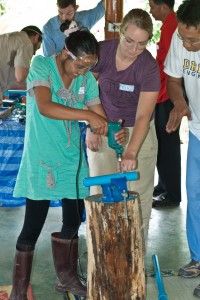 Alex Moseson 3 (USA)
Alex Moseson 3 (USA)
Caption: No Experience Required
Description: For the first time Den (left), a woman farmer in remote Bo Klua, Thailand, uses a power tool. She is assisted by a graphic designer and an interpreter in making her own ergonomic labor-saving weeder with the Drexel Thai Harvest program.
 Alex Moseson 6 (USA)
Alex Moseson 6 (USA)
Caption: The Mechanics
Description: A group of self-taught mechanics in remote Bo Klua, Thailand brainstorm design improvements for an ergonomic labor-saving planter with Drexel Thai Harvest founder Alex Moseson.
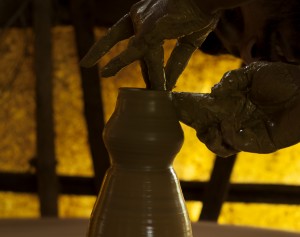 Bibin Mathew Joseph 2 (India)
Bibin Mathew Joseph 2 (India)
Caption: The Working Hands
Description: Simple ancient technology with a will power keeps the world clean for next generations.
Caption: From Darkness to Light
Description: The solar initiative aims to test and demonstrate the utility of solar applications to meet the power requirements of the Common Service Centres (CSCs) established in remote areas of the country and provide lighting opportunities to the communities they serve, based on a revenue model. A user from Jammu and Kashmir is shown in the photo with the solar lantern she rents from CSCs to light her home.
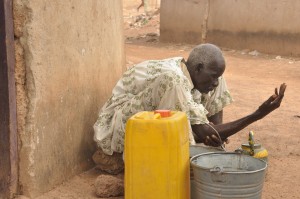 Sathyan Velumani 10 (India)
Sathyan Velumani 10 (India)
Caption: Daily Prayers Don’t Stop Because of Water
Description: In Dec 2011, I had the opportunity to conduct field research near Savelugu Village, Northern Region, Ghana. In this dry and dusty place everyday life isn’t easy. With their struggle to get the most basic need of life, water, everything else becomes secondary. The size and shape of water containers are so many and so is the size of the people who carry them. Daily life didn’t stop because of this, they pray 5 times a day and enjoy their football. These photos don’t show any technology in context. Why? Because its missing!!
Caption: The Human Washing Machines of Mumbai
Description: This incredible open-air Laundromat at the Mahalaxmi Dhobighat, Mumbai, India, rhythmically echoes the sounds of clothesslapping on stones by washer men. Thoughthe Ghat is also equipped with an automaticlaundry machine, the real spectacle remainsthe marvel of hand washing. The Ghat catersto laundry needs of hundreds of hospitals, hotels, and private organizations in the heartof Mumbai, and represents an epitome of human synergy, technical skills, and imperturbable concentration.
Caption: Brighter Future through Appropriate Technology
Description: Engineers Without Borders member Alanta Colley and local children build a solar cooker as part of NAIDOC Week – a celebration of Australian Aboriginal Culture at Yorta Yorta Nation – Victoria.
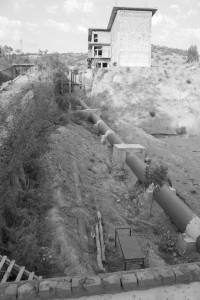 Kendra Sharp 5 (USA)
Kendra Sharp 5 (USA)
Caption: A Micro-hydropower Plant is Used to Provide Power to tTis Ice Factory in Northern Pakistan
Description: The microhydro power plant outside of Islamabad, Pakistan, includes locally-manufactured components. (The penstock connects at its lowest point to a power house that is not visible in the photo). The power provided by the system is used for the ice-making factory (shown).
Caption: Making Waves with Deep Waters
Description: With the water table dropping at rapidspeed, conservation of drinking water hasbecome a leading agenda not just with environmentalists, but with governmentsand social workers. The importance of clean drinking water needs no description, neither does the imminent dangers posed by water borne diseases. With state-of-the-art technologies for water purification systems and new technologies like ‘atmospheric water generation’, now being used in India, and with voluntary efforts of programs like CLEAN-India, a large part of rural Indiais gradually gaining access to clear drinking water.
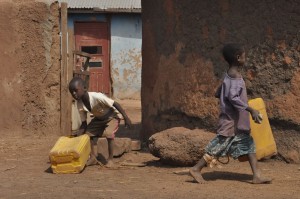 Sathyan Velumani 5 (India)
Sathyan Velumani 5 (India)
Caption: Getting Ready to Get Water
Description: In Dec 2011, I had the opportunity to conduct field research near Savelugu Village, Northern Region, Ghana. In this dry and dusty place everyday life isn’t easy. With their struggle to get the most basic need of life, water, everything else becomes secondary. The size and shape of water containers are so many and so is the size of the people who carry them. Daily life didn’t stop because of this, they pray 5 times a day and enjoy their football. These photos don’t show any technology in context. Why? Because its missing!!
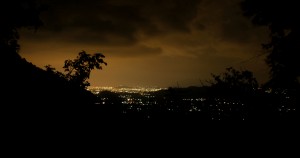 Bibin Mathew Joseph 6 (India)
Bibin Mathew Joseph 6 (India)
Caption: The Glowing City






